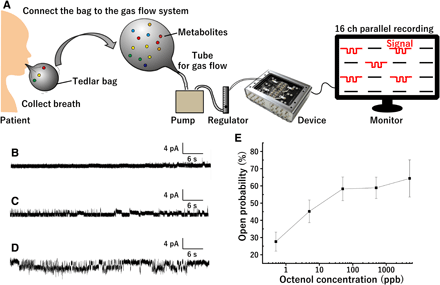
东京大学:通过蚊子气味成功检测气味:检测肝癌体征
东京大学:
神奈川县产业技术研究所:
东京大学和神奈川县工业技术研究所的研究团队宣布成立。
内置嗅觉感受器的传感器:
通过结合“在蚊子的触感中并能感知人的气味的嗅觉感受器”制成的传感器。
该研究小组成功地“检测到少量气味,表明人类呼吸导致癌症发展的程度”。
它于13日在美国科学杂志上发表。
通过呼气检测到“肿瘤标志物”:
将来,将有可能检测出数字“肿瘤标记”,这些数字指示呼出气中癌症进展的程度。
气味反应传感器的开发:
该研究小组开发了一种机器人,该机器人利用嗅觉蚊香的嗅觉感受器响应气味来移动。
它是一种机制,可创建电路,电信号流经该电路,并使它成为感应器。
该研究小组已经开发出一种“在人工细胞膜中结合了受体的传感器”。
当感测气味分子时,使气味和受体很可能结合。
检测肝癌的气味:
研究小组使用该传感器测量含有“辛烯醇”的气体,该气体被认为是指示肝癌进展程度的肿瘤标志物。
结果,我们成功地检测到了0.5 ppb的痕量气味(ppb是表示十亿分之几的单位)。
伊莎!
https://www.iza.ne.jp/smp/kiji/life/news/210114/lif21011409100003-s1.html
东京大学:蚊香受体的呼吸诊断!
-使用蚊香受体的传感器:成功检测到0.5 ppb的气味-
2021.01.14
公告要点:
◆我们通过使用在人工细胞膜上结合了蚊香味受体(注1)的气味传感器,成功地嗅出了少量的ppb ppb且与呼气混合的0.5 ppb癌症标志物。
◆明确了通过使含有气味分子的气体沿剪切方向流入水溶液,可以将难溶于水的气味分子从空气有效地分配到水溶液中。
◆我们将实现一种灵敏度和分子识别能力超过传统技术的气味传感器,并将其应用于呼吸诊断,环境测量,危险物质检测等。
-东京大学生产技术研究所
https://www.iis.u-tokyo.ac.jp/ja/news/3457/
Highly sensitive VOC detectors using insect olfactory receptors reconstituted into lipid bilayers
Science Advances 13 Jan 2021:
Vol. 7, no. 3, eabd2013
DOI: 10.1126/sciadv.abd2013Abstract
This paper reports a volatile organic compound (VOC) sensor based on olfactory receptors
that were reconstituted into a lipid bilayer and used in a specifically designed gas flow system for rapid parts per billion (ppb)–level detection.
This VOC sensor
achieves both rapid detection and high detection probability because of its gas flow system and array design.
Specifically, the gas flow system
includes microchannels and hydrophobic microslits, which facilitate both the introduction of gas into the droplet and droplet mixing.
We installed this system
into a parallel lipid bilayer device and subsequently demonstrated parts per billion–level (0.5 ppb) detection of 1-octen-3-ol in human breath.
Therefore, this system extends the various applications of biological odorant sensing, including breath diagnosis systems and environmental monitoring.
Science Advances